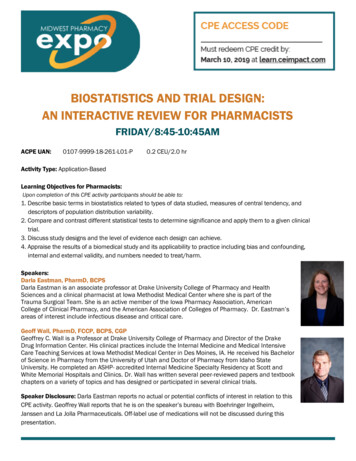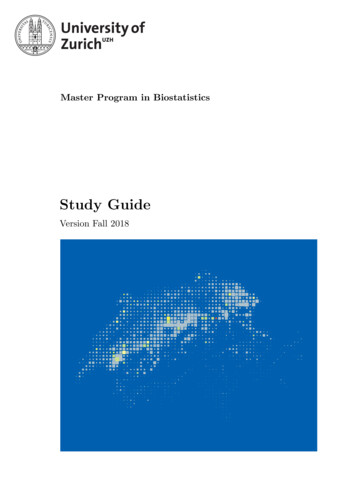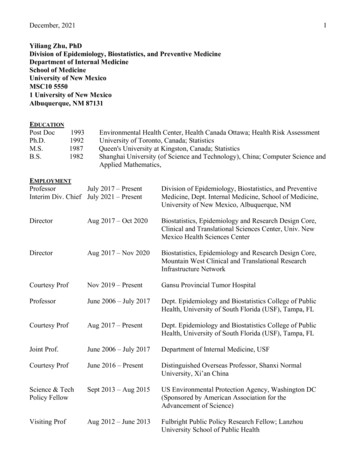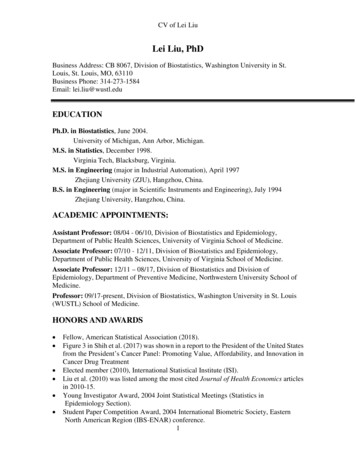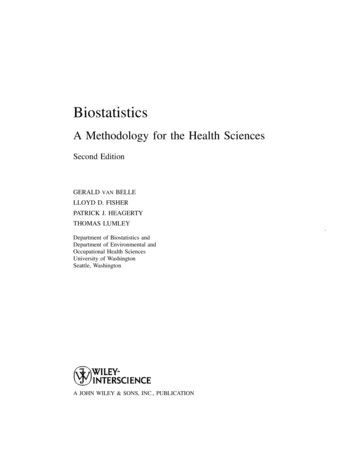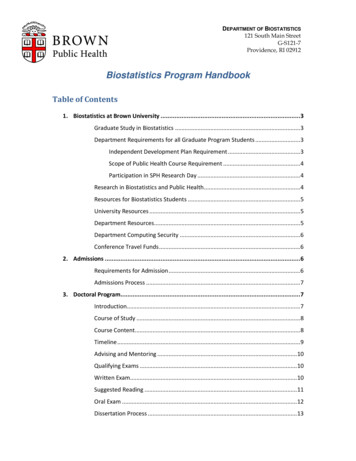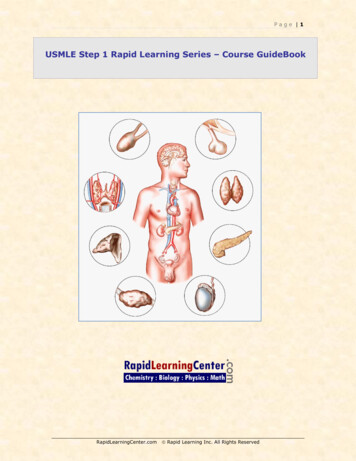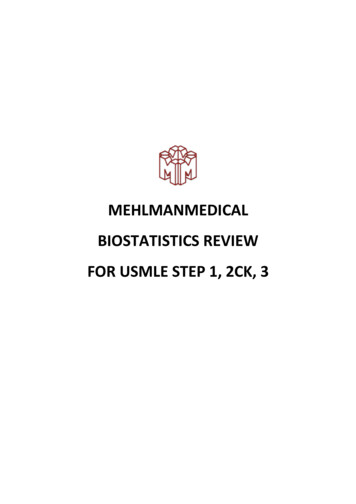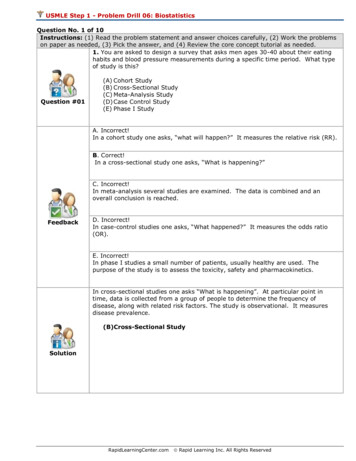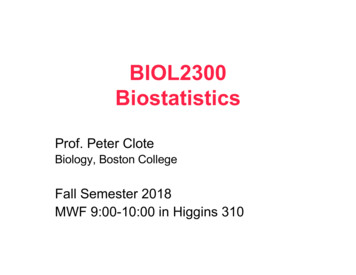
Transcription
BIOL2300BiostatisticsProf. Peter CloteBiology, Boston CollegeFall Semester 2018MWF 9:00-10:00 in Higgins 310
Course Mechanics TA: Rayane Dennaoui, Biology graduate student Emails: clote@bc.edu, dennaoui@bc.edu Course webpage – google “Clote Lab”, then followlink to “Current Courses” Direct linkhttp://clavius.bc.edu/ clote/courses/BIOL2300 Password to notes and homeworks: “biol2300”
Course Mechanics Office Hours for Prof Clote Mon 1-2 pm, Wed 12-1, Fri 10-11 in Higgins 577 Tel: 617 552-1332 Email: clote@bc.edu Office Hours for Rayane Dennaoui Tue 4:30-5:30 pm, Thur 3:30-5:00 in Higgins 577. Tel: 857-800-3460 Email: dennaoui@bc.edu
Course MechanicsGrade Determination––––10%: Weekly homeworks, class participation10%: unannounced quizzes50%: two midterms (Oct 10 and Nov 21)30%: Final Exam Fri Dec 14 at 9:00 am in Higgins 310.– possible modification of grading policy during semester –if so, you’ll be notified
Course Mechanics Textbook: Biostatistics for the Biological and HealthSciences, by Marc M. Triola and Mario F. Triola and Jason Roy.Pearson, Addison Wesley, ISBN 978-0-13-403901-5(hardcover), ISBN 978-0-13-403901-7 (softcover), 2nd editionSince 2006, Triolo-Triola and now Triolo-Triolo-Roy is one of themost widely used biostatistics books in USSTATISTICAL CALCULATOR needed for tests and finalexaminationExcel and Mathematica for in-class demos and (optionally)homeworkDownload site for ce.html
Course Mechanics Homework collection policy: hardcopy ONLY,stapled, with homework assignment number, yourname and date. NO EMAILED homework!!! No late homework. ACADEMIC INTEGRITY POLICY– See statement on course webpage– Any infringement will be turned over to theAcademic Integrity Board
Course goals Descriptive statistics, probability theory (binomial,hypergeometric, Poisson, normal distributions),hypothesis testing, correlation and regression, nonparametric statistical tests Use Excel and Mathematica for statistical analysis. Comprehend, critique, and communicate researchfindings from biomedical literature.
Caveats BIOL2300 requires differential and integralcalculus to really understand concepts, andeasily remember formulas; however calculusis not necessary to do any of the problems instatistics. Class mandatory Please turn OFF phones!
Florence Nightingale1820-1910
Rose diagram introduced by F. NightingaleStatistical Analysis of Circular Data By N. I. Fisherhttp://books.google.com/books
Ludwig Boltzmann1844-1906 Nothing is more practical than a goodtheory.
Statistics is routinely misunderstood or incorrectlyused in medicine and health sciences! In a study by (Anthony, 1996) the use of statistics inpapers from high-quality medical research journalswere analyzed. He reports that statistical errors andmisunderstandings of statistical concepts are almostthe norm rather than the exception. Errors werefound in more than 45% of all papers reviewed.” D. Anthony (1996). A review of statistical methods inthe journal of advanced nursing , J Adv Nurs 24(5):1089-1094.
Statistics provides arigorous framework in whichto analyze and understandbiological data
Statistics matters!Ethical misconduct in medical andpharmacological research maymisuse statistics to falsely portraybenefits of new procedure or drug.
Definitions data: observations (measurements), may bequalitative or quantitative census: collection of data from each memberof population sample: collection of data from (small) subsetof population parameter: numerical summary of values forentire population (fixed number, often notknown exactly) statistic: numerical summary of values basedon a sample (generally different samplesproduce different summary numbers)
Type of data
Example of statistics and parameters
Discrete vs continuous discrete data: values from either a finite orcountably infinite set– in survey of 100 students, 37 liked Starbuck scoffee continuous data: values from a real intervalor union of real intervals– average internal energy in gas at giventemperature
Current hype around “Big Data”
Experiment vs. observation
Retrospective versusprospective study cross-sectional study: data areobserved/collected at one point in time NOW retrospective study: data are collectedby going back in time PAST prospective study (cohort) study: dataare collected in future from groups,called cohorts FUTURE
Experimental study
Observational study
Another example ofobservational study
Example
Sources of error sampling error: difference betwensample result and true population result nonsampling error: data incorrectlycollected (eg sampling bias,nonresponse bias, response bias)
Simple random sampling Throughout course, we will assume thatsampling is simple random sampling withno bias. The manner in which polling is done isIMPORTANT. On Jan 10, 2017, the majorFrench newspaper, Le Parisien, announcedthat it will no longer pay Ipsos for pollingsurveys on political races (in the past, LeParisien had spent 30 million per year forpolls).
Textbook: Biostatistics for the Biological and Health Sciences, by Marc M. Triola and Mario F. Triola and Jason Roy. Pearson, Addison Wesley, ISBN 978-0-13-403901-5 (hardcover), ISBN 978-0-13-403901-7 (softcover), 2ndedition Since 2006, Triolo-Triola and now Triolo-Triolo-Roy is one of the mo

